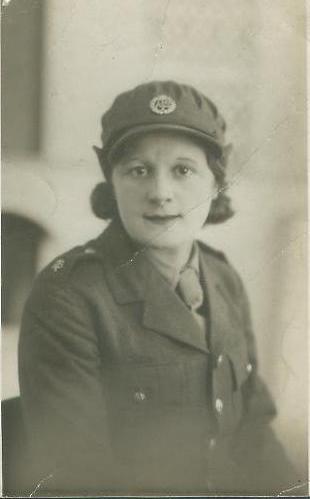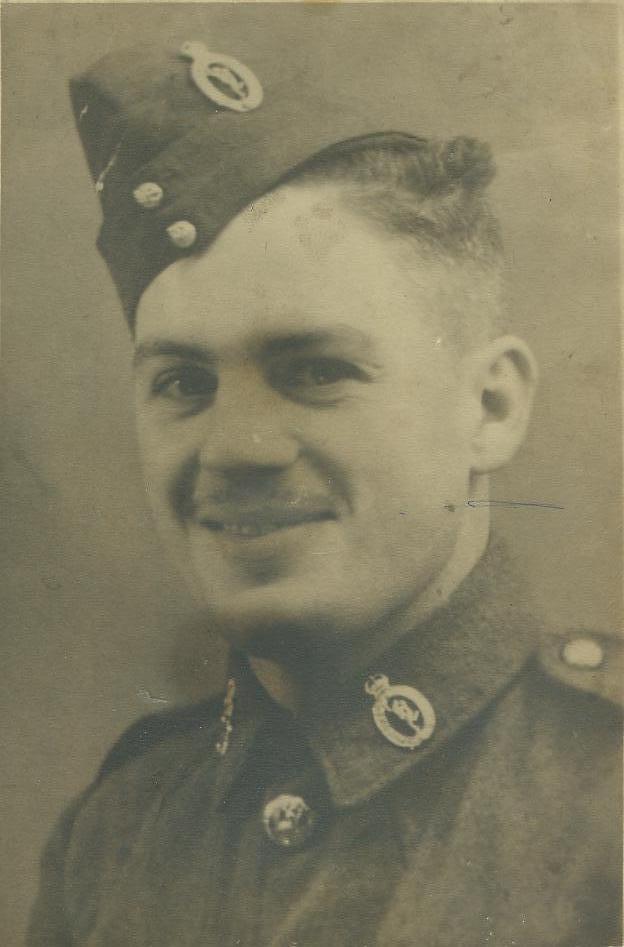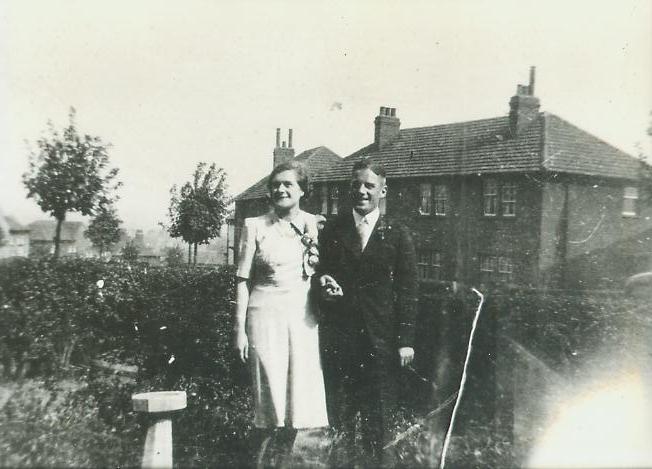Irene and Harry Briscoe
Date of birth: 14.2.1916
Date of death: 19.6.1997
Area: Lupset
Regiment: Womens' Auxiliary Territorial Service
Family information: Wife of Harry Briscoe
Rank: Corporal
Service number: W/7694
War Service
My grandma wouldn’t talk about her war service to us at all. She said that she had signed the ‘Official Secrets Act’ when she enlisted and this meant that she couldn’t discuss it. What little we do know is taken from her service records and reminiscences of other family members.
Irene was 23 years old and still living at home when she enlisted in the armed forces on 20th February 1939. War still hadn’t officially broken out but it was very obviously going to happen soon. Women could only join so-called ‘auxiliary units’ which supported the main armed services or those which helped the war effort. She volunteered to join the Women’s Auxiliary Territorial Service (ATS) and was enrolled with the 24th West Riding Company with the rank of ‘volunteer’. The ATS used a completely different ranking system to that used by other army units. Instead of ‘private’ you were a ‘volunteer’ and a ‘sub-leader’ was the equivalent of a ‘corporal’.
Enlisting for the ATS in the Wakefield area took place at the Drill Hall. She was weighed and measured and had to answer a lot of questions about herself in order to see if she was suitable for the ATS. Irene had some knowledge of book-keeping from her work at Crystal Springs mineral water plant in Wakefield so she became an administrative clerk.
On 13th September 1939, Irene was finally called up to active service in the ATS. She now was officially a member of the armed forces and was posted at the 1/4th battalion of the King’s Own Yorkshire Light Infantry (KOYLI) in Wakefield for training. Here she qualified as a ‘Clerk Grade B’ and was given her initial training. She must have done well however, as she was made up to ‘sub-leader’ by the end of December 1939.
After 7 days of leave she was reposted and transferred to ‘A’ Company, 39th Group ATS which was based at Sedgefield in County Durham. This unit was a company within the ATS but was actually under the command of the 7th Anti-Aircraft (AA or Ack Ack) Divisional Headquarters. The 7th Division was known as ‘Northern Command’ and it had overall responsibility for defence for the north of England against any airborne i.e. enemy planes, flying bombs etc. Divisional Ack Ack headquarters had command of a large network of anti-aircraft guns and searchlight batteries. Searchlights and ‘spotters’ looked for enemy aircraft as they came over the coast and ‘lit them up’ to enable the huge guns to shoot down the planes before they could drop their bombs. We know that my grandma sometimes worked with one of the ‘mixed’ searchlight units which was manned by men and women of the 63rd Medium Artillery Regiment.
Irene then became a personal assistant to an officer in the Pay Corps section. This meant he was in charge of paying wages to all of the troops within the 7th AA division. She was billeted with a local family called Fearby who lived in Sedgefield. The army paid the family to provide a room and board for my grandmother and they were very good to her. She kept in touch with them throughout the whole of the rest of her life and visited them regularly.
Irene took a short period of leave when she married her fiancé Harry Briscoe on 31st August 1940. They only had a week together before they had to rejoin their units. Irene went back up to Sedgefield. Her life remained pretty much the same as before her marriage as she still lodged with the Fearby family and worked as a clerk. Between 14 October and 16th November 1940 she was also required to work on a searchlight unit during enemy raids. Officially she was now part of the 4th Northumberland Company which itself was part of ‘F’ company, 36th Group ATS.
Sedgefield was at risk from air attack because it is only 10 miles north of Middlesbrough, which was, and is, a very industrialised town. This made it a very tempting target for enemy bombers. Ack Ack batteries in Middlesbrough tried to force planes away from the city into ‘killer zones’ further inland. These were areas with large numbers of searchlight and artillery units which would highlight the plane before destroying it. It would have been extremely busy time for Irene if she worked as a clerk during the day and on the searchlights at night.
During the early months of 1941, my grandmother is recorded as being on sick leave quite a few times. She was admitted to Henry Knowles Hospital between the 19th and 31st March of 1941.
Between bouts of illness she seems to have been an extremely hard worker. Her boss even requested that she should stay with him to work as his assistant when he was given a temporary posting with the 12th City of London ATS (1st AA HQ). This meant moving down to Bushy Heath, Hertfordshire She worked there between April and June 1941 before being transferred back to the 4th Northumberland Company at Sedgefield. She remained there until 19th September 1941 when she was discharged from the ATS because she was pregnant with my father, David. She then returned to her family home in Potter Avenue, Lupset, ‘pending her certificate of discharge’.
Throughout her war service she seems to have been a very good clerk as she was rewarded with regular free warrants (tickets) to go and visit her husband and family. Her war service is described as follows in her certificate of discharge;
Military Conduct: Very good during her 2 years 6 months service.
Testimonial: This corporal has worked very well. She has an excellent record of work with the unit to which she was attached on shorthand/typing duties. A most suitable clerk for re-enrolment.
Family Life
Irene was the oldest of Hetty and Albert Blockley’s four children. When war broke out in 1939, she was still living with her parent’s at the family home on Potter Avenue, Lupset. Her time in Sedgefield in County Durham was the first time she had lived away from home. It had a huge impact on her family life as she had been helping her parents to raise her two younger brothers who were still small children.
By this time, my grandmother had become engaged to be married to Corporal Harry Redmond Briscoe who served in the Royal Corps of Signals. She had met him just prior to the war when she was introduced to him by a mutual friend.
Harry was at that time overseas in France as part of the British Expedition Force (BEF). He was a radio operator working as part of the 2nd Air Formation Signals (part of Bomber Command). At Dunkirk in 1940, he was unable to be evacuated with the other troops because he was a signalman. He was needed to keep British Commanders informed about the location of the approaching enemy and about the troop evacuation on the beaches. According to his best friend Harry Bell, who was with him in Normandy, they were overrun by enemy troops and had to make their own way home via Spain. They were eventually brought home in a fishing boat!
Irene married her fiancé on 31 August 1940. Despite not being too far into the war, there were already huge shortages of food, metals and other materials. This had a huge impact on her wedding day. Clothing was rationed and there was no fabric available for a wedding dress. This meant that my grandmother had to get married in her ‘Sunday Best’ outfit, which basically means the best outfit that she already had. Since, sugar, flour and butter were all rationed they couldn’t have the traditional three-tier wedding cake. Instead there was a tiny little cake made up of ingredients scrimped and saved from the rations by various family members.
The war also meant shortages of precious stones and metals like diamonds, gold and silver which meant there was very little available to for wedding rings. Like many others, both her engagement and wedding rings were part of the ‘utility’ range of jewellery. The metal is much thinner (about half as thick) than a normal wedding band and can be easily bent by hand. Even the engagement ring was decorated with diamond chips rather than the traditional ‘solitaire’ large stone.
One thing we have noticed is the extra details given on the wedding certificate they were issued with after their marriage. In the column marked rank or profession, both of my grandparents have given their army numbers and regiments as well as their peacetime professions.
After their short honeymoon, both my grandparents had to return to their respective army units. Life continued just as it had before their marriage although they managed to meet each other for short periods of leave throughout 1940/1. When Irene became pregnant with my father in 1941 she could not stay with the ATS and she was released from service on compassionate grounds. Her son, David, was born on 4th March 1942 at Wakefield Maternity Hospital. When they were allowed to leave the hospital, my grandmother took her son back to her parents’ house.
My grandfather was not there for David’s birth as he had been posted overseas to the Middle East. He eventually became part of the Persia and Iraq Command (PAIFORCE) and was stationed in the desert until the middle of 1946. This meant that my father was about 41/2 years old before he saw his dad.
My grandmother realised that her husband would miss out on much of their son’s childhood. From a very early age she began to take photographs of David regularly even though photographic film and development was extremely expensive during wartime.
Very little post was able to get through to and from servicemen posted overseas. The government was terrified that ‘Careless Talk Costs Lives!’ and heavily censored forces mail. Harry used to send very short ‘form’ letters and telegram cards to his loved ones. A few of those have survived but they show how little he could tell his family about his life in the desert.
Irene didn’t rejoin the ATS as she wanted to stay at home with her son. Instead she went back to her old job as a clerk at the Crystal Springs Mineral Water Company in Wakefield. Later in the war she also used to collect insurance premiums in Wakefield. In her spare time she helped to raise her two younger brothers and generally helped her parents around the house.
My grandmother always hated the war for taking her husband away from her and her child, especially since he was away for such a long time. My dad couldn’t recognise his father when he finally met him in 1946. Harry had gone away to war as a boy with a full head of hair but when he came back he was a changed man. Irene was very happy when he came home but she always said it was like getting to know another person.
Although she only served for 2 years and 6 months, her service records show that she actually was eligible for a medal for her time in the ATS (i.e. War Medal 1939-1945). We were quite surprised to see that Irene chose not to apply for it after the war. However, our family believes that her time in the ATS had a significant impact on her life and so we have chosen to apply for it in her memory.
 Irene Briscoe
Irene Briscoe
 Harry Briscoe
Harry Briscoe
 Irene and Harry Briscoe. Wedding photograph taken at Lupset
Irene and Harry Briscoe. Wedding photograph taken at Lupset

